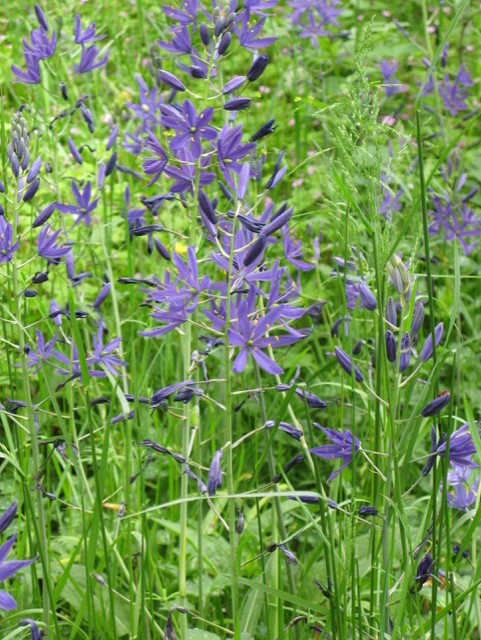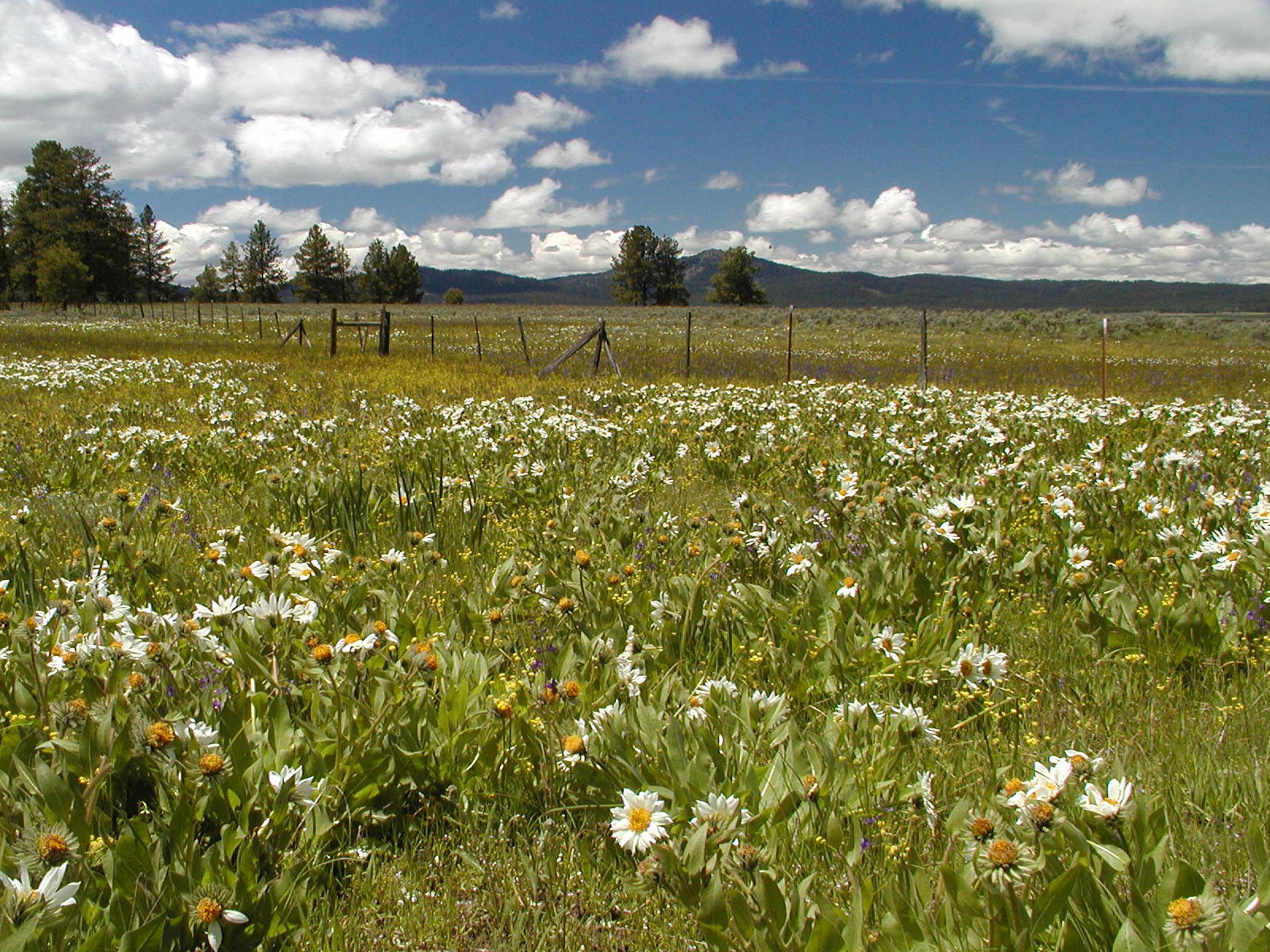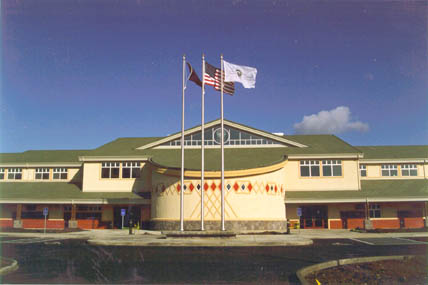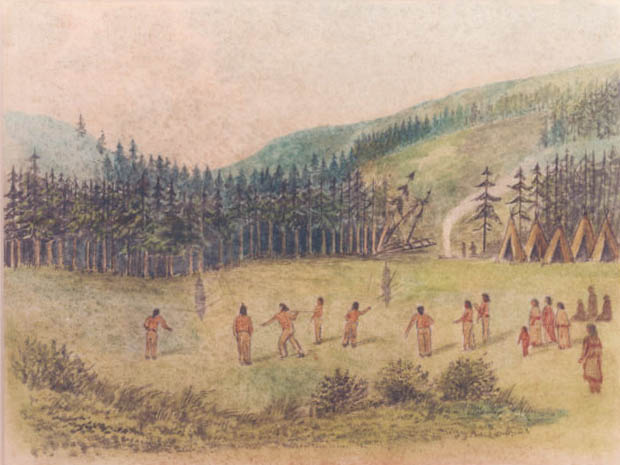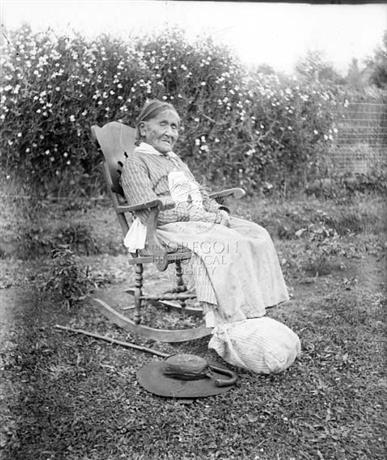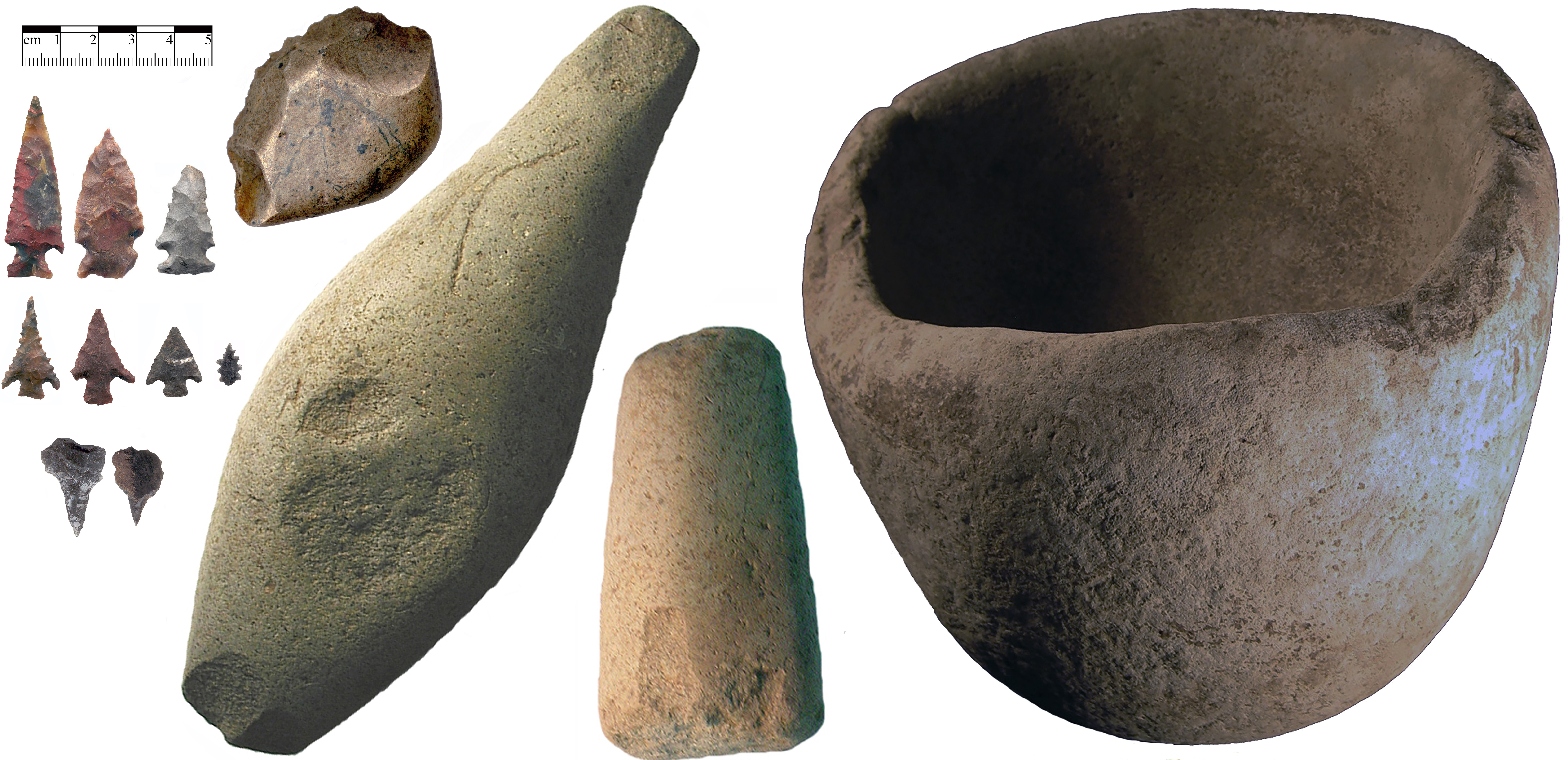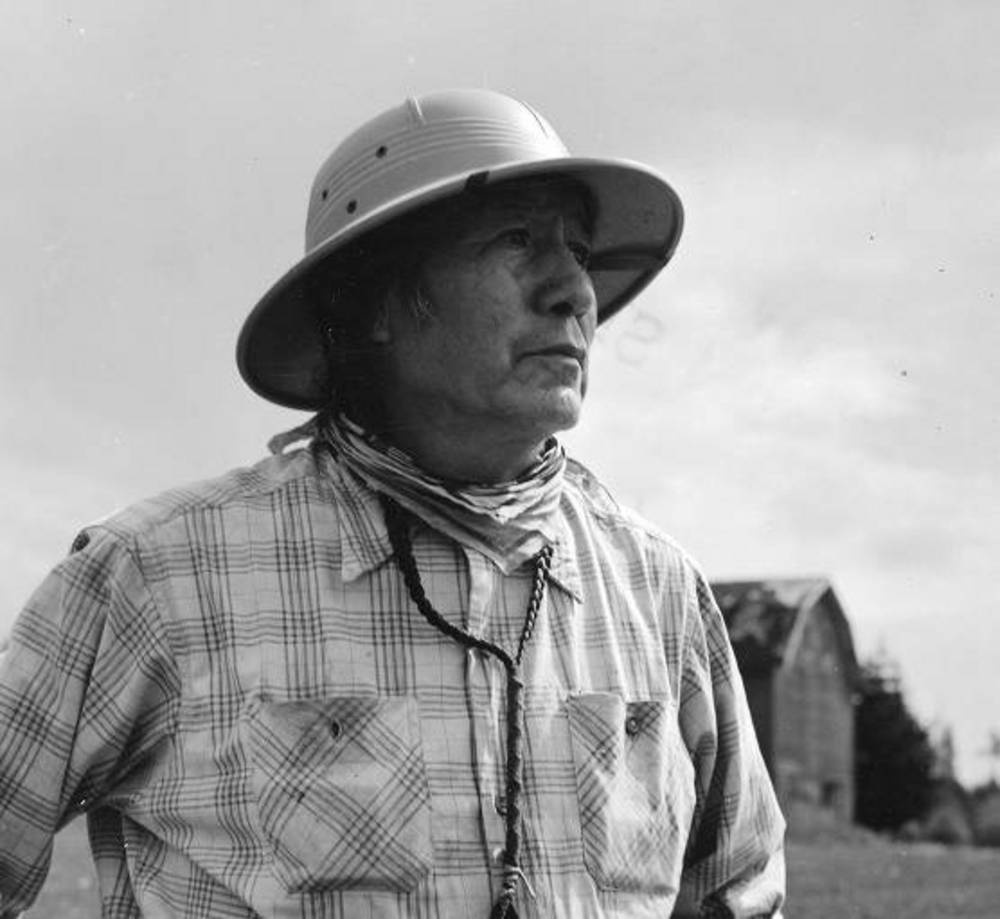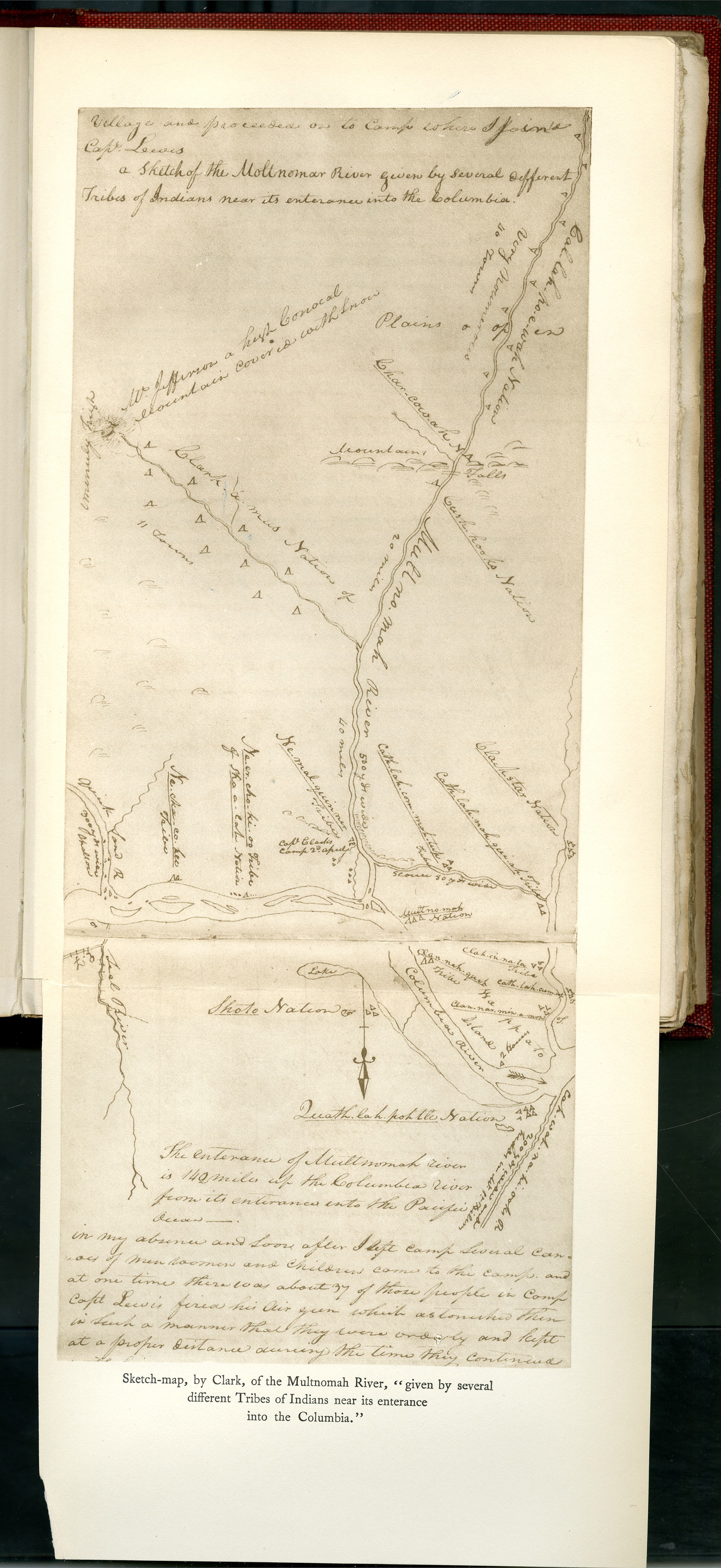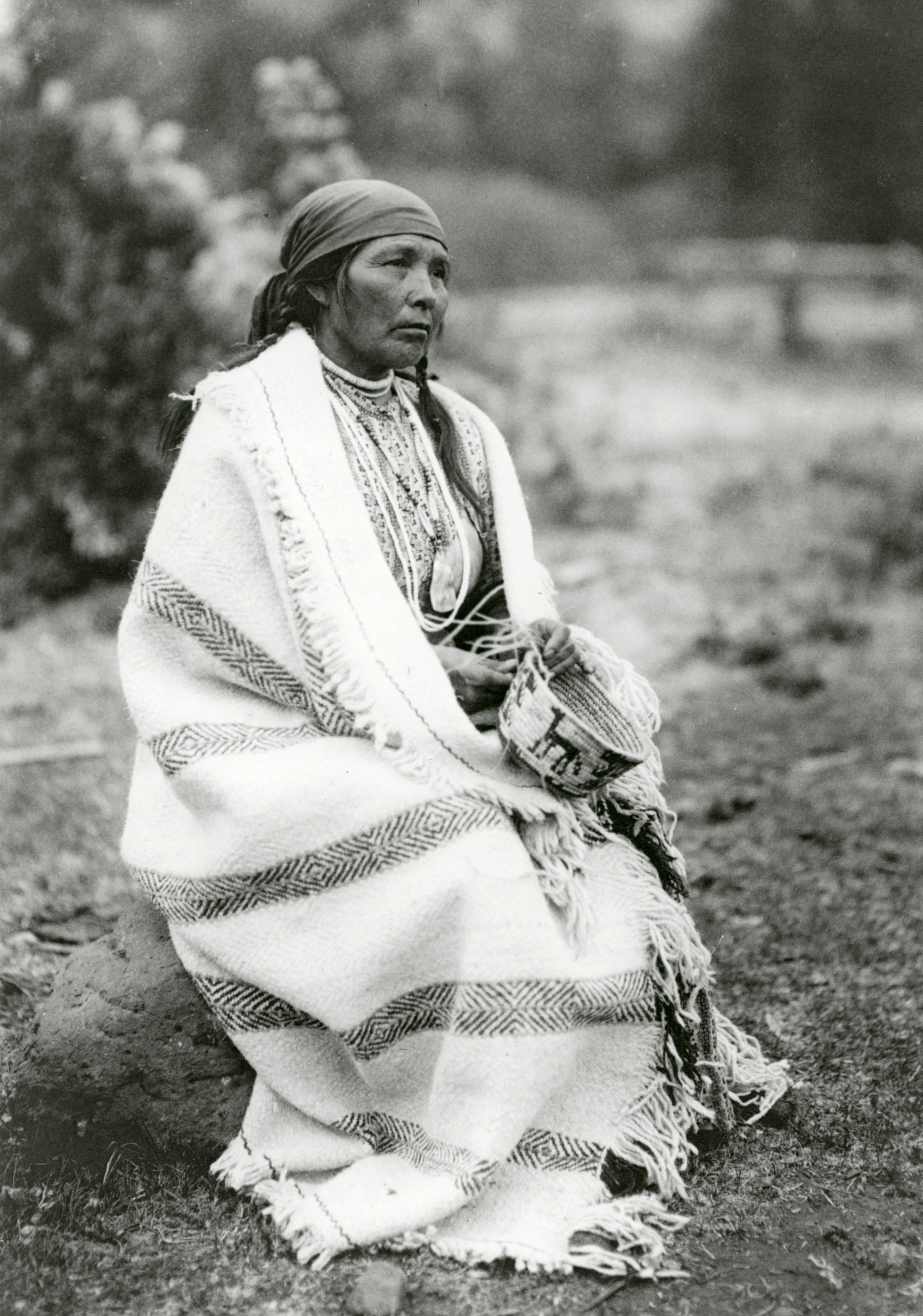Camas is a North American bulb-forming geophyte whose greatest diversity lies in Oregon, home to over 65 percent of the named species. The names Camassia, camas, qém’es, quamash, and pa-siko all refer to the group of spring herbs whose white to blue-purple flowers form spectacular displays in wetlands, grasslands, and oak savannas in the Pacific Northwest.
From California to coastal British Columbia, Indigenous peoples used camas bulbs extensively for food, along with salmon, acorns, and other foodstuff. The bulbs were valued as sweeteners and were shared or traded as gifts at weddings and funerals. Traditional harvest sites and practices were carefully passed down across generations. From spring to late summer, women dug the bulbs with special sticks crafted of wood and animal antlers. After harvest, the bulbs might be ground and stored in cake form. At special gatherings, families baked the bulbs in deep earthen ovens, cooking them over hot stones, layered with branches of shrubs, herbs, and trees until tender and sweet.
Tribes such as the Kalapuyans of the Willamette Valley actively traded camas. In 1805, the Nez Perce shared their bulbs with members of the Lewis and Clark Expedition on Quawmash flats (Weippe Prairie in present-day Idaho), rescuing the party from near starvation. The explorers suffered gastrointestinal misery from eating the camas, yet on their return trip to the East the next spring Meriwether Lewis observed en masse the profuse blooms that “resemble lakes of fine clear water." At Quawmash flats, he collected the first specimen, or holotype, that today is associated with the most common species of western camas, Camassia quamash.
In Oregon and adjoining states, camas plants vary greatly in form and ecology, with ten different subspecies and four species growing at elevations from sea level to 3,300 meters. Camassia flowers from April to June in a climate that ranges from Mount Hebo on the north Oregon Coast to the remote reaches of Hells Canyon Overlook (i.e., Cusick’s camas) in eastern Oregon. In southwest Oregon, the rarer Howell’s camas grows on unusual serpentine-derived soils in Douglas County.
The Willamette Valley harbors the two most common, often co-occurring species: C. leichtlinii and C. quamash. Camassia leichtlinii, or great camas, the larger of the two, is mainly limited to sites west of the Cascade Mountains while subspecies of C. quamash extend from the Oregon Coast to Montana. Molecular and morphological studies show that both species are genetically distinct, despite some hybridization. All species are ecologically important for their abundance and for the nutrition they provide to diverse spring pollinators and animals such as the camas pocket gopher (Thomomys bulbivorus). Camas “lilies” are important culturally and ecologically, and three of the Oregon species are available as garden cultivars. In southwest Oregon, villagers at Coos Bay and along the Coquille River harvested both Brodiaea and camas, and the Northern Paiutes dug fernleaf biscuitroot (Lomatium) for medicinal uses.
Today, existing camas populations with ecological, cultural, and genetic value, are at risk for multiple reasons that, if addressed, can yield solutions that will sustain future communities of plants, animals, and humans. By 2020, vascular plant extinction globally and in the continental U.S and Canada since European settlement have declined markedly due to climate change, population growth, and land use patterns. Indigenous and local knowledge (ILK), linked with new conservation research, are fostering synergistic results that in collaborative studies retain ecosystem function, resilience, taxonomic integrity, and community diversity.
As a cultural and ecological keystone species, camas is highly valued for restoration in wet prairies, wetlands, and savannas by nongovernmental organizations, tribal organizations and government agencies. Within the 110 ha Weippe Prairie National Historic Landmark, National Park Service scientists and Nez Perce specialists guided a multiyear experiment using traditional resource management (TRM). In 50 permanent plots, embedded in wild camas populations, they tested burning and bulb digging against controls, finding that combining treatments in a five-to-six-year harvest cycle allows sustainable harvest and effective population recovery. Recent studies of Pacific Northwest-California Camassia imply high within-species variability, wide-ranging habitats (low coastal or inland wetlands to montane outcrops), and tolerance to summer drought with deep-seated bulbs; generalist pollinators can also equip Camassia well in changing climates, provided water is accessible for bud-flower production. Retaining resilient communities and augmenting camas populations by sharing all conservation tools and practices remains critical, since its spring dominance affects entire communities in habitats converted for agriculture, transportation, and urban development.
In Oregon and elsewhere, Indigenous communities continue to harvest camas to commemorate its role in their cultural history. Recent dated archaeological and paleobotanical analyses of carbonized bulbs show that Native peoples have been actively maintaining camas or modifying harvest strategies for several millennia. Camas still grows on Native American reservations despite past and ongoing injustices, yet much more is needed to sustain ecological and indigenous communities. To solve the complex issues of the future and to meet the threats to lands, stewardship rights, and resources, global teams of scientists across diverse backgrounds (e.g., archaeology, biology, socioeconomics) have called for equitable change; their recommendations include creating educational programs to reduce cultural bias and prioritizing the restoration of keystone species. They also urge finding more ways to revitalize the transmission of traditional cultural practices intergenerationally and to apply them today while historical memory still exists.
-
![Depicts radial floral symmetry of tepals that twist off ovary after flowering and are deciduous with it if no fruit forms.]()
Camassia leichtlinii ssp. suksdorfii, Kingston Prairie.
Depicts radial floral symmetry of tepals that twist off ovary after flowering and are deciduous with it if no fruit forms. Courtesy Adam Kotaich, 2008.
-
![]()
Multiple shoots of large Camassia cusickii clumps along an open wet ravine, Hells Canyon, OR.
Courtesy Jim and Susan Kephart, 2007.
-
![Pale bloom is due to crossing of albino and blue flowered plants.]()
Population of Camassia quamash ssp. maxima, Bush Pasture Park. Early season blue flowers show bilateral symmetry, with old floral tepals that wither separately and persist on stem.
Pale bloom is due to crossing of albino and blue flowered plants. Courtesy Sebastian Mortimer, 2014.
-
![]()
Female Megachild bee pollinating C. quamash ssp. maxima, near Lyons OR, its abdomen full of pollen; the same bee also collected nectar at the flower’s base.
Courtesy Chris Ebeling, 2008.
-
![Today's populations of C. quamash ssp. quamash (flowers, fruit), fragmented by humans and land use, are now undergoing recovery using the combined tools and efforts of Nez Perce and National park service scientists.]()
Wild camas meadow at “Quamash flats” still creates a “blue skye” near Weippe prairie ID.
Today's populations of C. quamash ssp. quamash (flowers, fruit), fragmented by humans and land use, are now undergoing recovery using the combined tools and efforts of Nez Perce and National park service scientists. Courtesy James Reveal photos, combined by Molly Sultany, Susan Kephart (Sultany et. al, 2007).
Related Entries
-
![Big Summit Prairie]()
Big Summit Prairie
Located in the heart of the Ochoco Mountains, Big Summit Prairie is kno…
-
![Climate Change in Oregon]()
Climate Change in Oregon
Within a few hundred miles in Oregon, you can see snowy volcanoes, parc…
-
![Confederated Tribes of Grand Ronde]()
Confederated Tribes of Grand Ronde
The Confederated Tribes of Grand Ronde Community of Oregon is a confede…
-
![Indian Use of Fire in Early Oregon]()
Indian Use of Fire in Early Oregon
Anthropogenic (human-caused) fire was a major component of the Native s…
-
![Kalapuyan peoples]()
Kalapuyan peoples
The name Kalapuya (kǎlə poo´ yu), also appearing in the modern geograph…
-
![Mill Creek Archaeological Sites (Salem)]()
Mill Creek Archaeological Sites (Salem)
The modern City of Salem occupies a former Kalapuyan townsite known as …
-
![Native American Agricultural Labor]()
Native American Agricultural Labor
As early as the 1830s, when French Canadians associated with the Hudson…
-
![Wapato (Wappato) Valley Indians]()
Wapato (Wappato) Valley Indians
Lewis and Clark called them the "Wappato Indians," the people who inhab…
-
![Western Oregon Klikatats (Klickitats)]()
Western Oregon Klikatats (Klickitats)
Between the 1810s and 1850s, a sizable segment of the Klikatat Tribe of…
Related Historical Records
Further Reading
Anderson, K., F. Lake. Beauty, bounty, and biodiversity: the story of California Indians’ relationship with edible native geophytes. Fremontia 44 (2016): 44-51.
Archibald J. et al. Multilocus phylogenetic inference in subfamily Chlorogaloideae and related genera of Agavaceae–informing questions in taxonomy at multiple ranks. Molecular Phylogenetics and Evolution 84 (2015): 266-283.
Armstrong, C., J. Miller, A. McAlvay, D. Lepofsky et al. Historical indigenous land-use explains functional trait diversity. Ecology & Society 26 (2021): 6. https://doi.org/10.5751/ES-12322-260206.
Carney, M., S. Tushingham, T. Mcglaughlin, J. Guedes. Harvesting strategies as evidence for 4000 years of camas (Camassia quamash) management in the North American Columbia Plateau. Royal Society Open Science 8 (2022): 13.
Fernández-Llamazares, A. , D. Lepofsky et al. Scientists’ warning to humanity on threats to indigenous and local knowledge systems. Journal of Ethnobiology 41 (2021): 144-169.
Kephart, S. Camassia. In Flora of Oregon, ed. S. Meyers et al. Vol. 1, p.153-157. Fort Worth, TX: Botanical Research Institute of Texas Press, 2015.
Kephart, S., J. Kephart, and B. Robinson. Botanizing from Mt. Adams to the Klickitat River: the search for new and historical camas lilies. Douglasia 43 (2018): 6-10.
Kephart, S. Camassia Lindh. In Hitchcock and Cronquist Flora of the Pacific Northwest, ed. D. Giblin, B. Legler, P. Zika, R. Olmstead. Seattle: University of Washington Press, 2018.
Knapp, W., A. Frances, R. Noss et al. Vascular plant extinction in the continental United States and Canada. Conservation Biology (2021) 360-368.
Stucki, D., T. Rodhouse, and R. Reuter. Effects of traditional harvest and burning on common camas (Camassia quamash) abundance in Northern Idaho: the potential for traditional resource management in a protected area wetland. Ecology & Evolution 11 (2021): 16473-16485.
Sultany, M., S. Kephart, and P. Eilers. Blue flower of tribal legend: “Skye blue petals resemble lakes of fine, clear water”. Kalmiopsis 14 (2007): 28-35.
Turner, N., and K. Turner. “Where our women used to get the food”: Cumulative effects and loss of ethnobotanical knowledge and practice; case study from coastal British Columbia. Botany 86 (2008): 103-115.



